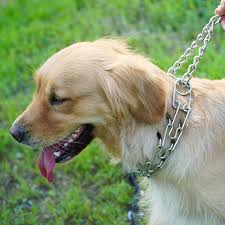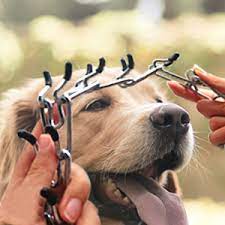A prong collar is tool dogs use to control their behavior during walks or training sessions. It consists of a series of metal prongs that pinch the dog’s skin when tension is applied to the leash, creating discomfort and prompting the dog to alter its behavior.
While some trainers swear by this tool as an effective way to train dogs, others criticize it for being inhumane and potentially causing harm. Despite its controversial nature, prong collars are widely used in dog training.
However, before deciding whether or not to use one on their furry friend, it’s essential for pet owners to understand both the potential risks and benefits associated with this tool. Additionally, alternative training methods can be as effective without force or pain.
This article explores all aspects of prong collars so readers can make informed decisions about their pets’ training regimens.
Key Takeaways
- Prong collars are controversial and can cause harm to dogs if not used properly.
- Positive reinforcement training is a more effective and humane alternative to punishment-based techniques.
- Alternative training methods include clickers, leashes, harnesses, and positive reinforcement training.
- Responsible dog owners should prioritize their pet’s well-being and seek professional help.
What is a Prong Collar?
A prong collar is a type of dog collar with metal spikes that can be used for training. The points on the collar are designed to apply pressure evenly around the dog’s neck when it pulls, making it uncomfortable for the dog to continue pulling.
The idea behind using this type of collar is that it will teach the dog not to pull on its leash and help them learn proper walking etiquette. One advantage of using a prong collar is that it can teach dogs obedience and good behavior.
However, it’s important to note that this type of training technique should only be used under the guidance of a professional trainer with experience working with these collars. Owners must understand how to use the collar properly and avoid causing any harm or injury to their furry friend.
The Controversy Surrounding Prong Collars

You may be wondering why there is so much controversy surrounding using prong collars. Some people argue that they are a cruel way to train dogs, while others believe they can be an effective tool when used correctly. The prong collar controversy concerns ethical concerns about how these collars work and whether they cause the dog pain.
Let’s look at how they work to understand better the debate surrounding prong collars. A prong collar is a training collar with metal spikes on the inside that press against the dog’s neck when pulled. Proponents of this type of collar argue that it mimics how a mother dog would correct her puppies by biting them on the neck. However, opponents say this method is outdated and unnecessary and causes undue stress and pain to the animal. To illustrate these opposing viewpoints, consider the following table:
| Argument For | Argument Against |
|---|---|
| Prong collars mimic natural correction methods | Mimicking natural methods doesn’t necessarily make it humane |
| Prong collars provide clear communication to dogs about what behavior is expected | Clear communication can also be achieved through positive reinforcement methods |
| Properly fitted prong collars do not harm dogs | Incorrect usage or fit can cause physical harm or injury to dogs |
| Prong collars have been used successfully for years in training working dogs such as police K-9s and search-and-rescue dogs | Other types of training tools (such as clickers) are equally effective without causing physical discomfort to animals |
As with any controversial issue, pet owners must educate themselves on both sides before deciding whether to use a prong collar on their furry friend. While some trainers swear by them, others view them as unethical and potentially harmful tools for training pets. Ultimately, whether or not to use a prong collar should be based on what is best for the individual dog and its unique training needs.
Potential Risks & Benefits of Prong Collars

When discussing prong collars, it’s essential to consider their potential risks and benefits.
One of the major concerns is that these collars can cause physical harm to dogs if used improperly or excessively. However, some trainers argue that prong collars can effectively train and modify behavior correctly.
Risks of Using Prong Collars
Beware of the potential dangers lurking beneath the surface when relying on a prong collar as your go-to training tool. While it may seem an effective way to control a dog’s behavior, prong collars have severe risks that should not be overlooked.
Here are some ethical concerns and specific dangers that come with using prong collars:
- Prong collars can cause physical harm to dogs, such as punctures, cuts, bruises, and neck injuries.
- They can also lead to behavioral issues in dogs, such as fear and aggression.
- Many experts argue that positive reinforcement methods are far more effective and humane than punishment-based techniques.
Benefits of Using Prong Collars
Imagine having a well-behaved and obedient dog that listens to your commands and respects your authority without resorting to harsh punishment or physical force. This is possible with the proper usage of a prong collar.
Contrary to popular belief, prong collars are not designed to hurt or harm dogs but to provide practical training results.
One of the benefits of using a prong collar is its training effectiveness. The collar applies pressure around the dog’s neck when they pull or disobeys, miming how their mother would discipline them in their early life stages. As such, it is a gentle reminder for dogs to follow their owner’s commands. It helps correct unwanted behaviors such as jumping, barking excessively, and pulling on the leash during walks.
However, it’s important to note that proper usage is crucial in ensuring that the collar doesn’t cause any harm or discomfort to the dog.
Alternative Training Methods for Prong Collars

Alternative training methods to prong collars include positive reinforcement training, clicker training, and leash and harness training.
Positive reinforcement training involves rewarding desired behaviors with treats or praise while ignoring or redirecting unwanted behavior.
Clicker training uses a clicking sound to mark desirable behavior and is often used with positive reinforcement.
Leash and harness training focuses on teaching the dog to walk calmly on a leash without pulling or tugging.
Positive Reinforcement Training
You’ll love how quickly your furry friend learns new tricks with positive reinforcement training – it’s like they become a genius overnight! This training involves rewarding good instead of punishing bad behavior, creating a more positive and enjoyable learning experience for you and your dog.
Positive reinforcement training is highly effective in teaching dogs new behaviors and commands and strengthening the bond between you and your pet. One of the main reasons why positive reinforcement training is so practical is that it focuses on encouraging desirable behaviors rather than punishing undesirable ones.
This means that instead of resorting to aversive methods like shock collars or prong collars – which can cause physical pain and emotional distress – you reward good behavior with treats, praise, or other forms of positive reinforcement. Not only is this approach more ethical, but it also creates a more trusting and respectful relationship between you and your dog.
Using positive reinforcement training techniques, you can teach your furry friend everything from basic obedience commands to impressive tricks and complex tasks like search-and-rescue work.
Clicker Training
Try clicker training to have fun while training your furry friend. It’s an effective and enjoyable way to teach your dog new behaviors using a clicking sound as a marker for good behavior.
Clicker training techniques are based on positive reinforcement training strategies, which focus on rewarding desirable behaviors rather than punishing undesirable ones. One of the benefits of clicker training is that it allows you to be more precise in your communication with your dog.
You can tell your dog exactly what behavior you’re rewarding by timing the click right. This helps to avoid confusion and builds trust between you and your pet. Clicker training also encourages creativity and problem-solving skills in dogs and their owners, making it an excellent option for those who want to bond with their pets while teaching them valuable skills.
Leash and Harness Training
Leash and harness training is like putting a puzzle together with your dog as you work together to find the right fit for comfort and control. It’s essential to start with the right tools and approach, especially if your dog tends to pull on their leash.
Here are some tips to help you train your furry friend:
- Use positive reinforcement techniques such as treats or praise when they walk calmly beside you.
- Start slow and gradually increase the distance of walks, allowing them time to adjust.
- Choose a comfortable harness that fits snugly but doesn’t restrict movement.
- Consider using a front-clip harness or head halter if your dog continues to pull excessively.
With patience and consistency, leash and harness training can be an enjoyable experience for you and your dog. Remember that each pup learns at its own pace, so don’t get discouraged if progress seems slow at first. Keep practicing; walking with your furry companion will soon be a breeze!
Conclusion and Recommendations
In conclusion, this article discussed alternative dog training methods, specifically the prong collar. While some trainers may find it compelling, others argue that positive reinforcement-based training is a more humane and practical approach.
It’s recommended that responsible dog owners prioritize their pet’s well-being and seek professional help if necessary to ensure safe and effective training practices.
Summary of Key Points
One effective tool for training dogs is the prong collar, which can help correct behavior issues and improve leash manners. While it may look intimidating to some pet owners, the prong collar has proven to be an effective training aid when used correctly. Compared to other collars, such as flat or choke collars, prong collars distribute pressure evenly around a dog’s neck, making it less likely to cause injury.
If used correctly and responsibly, the prong collar can significantly benefit the owner and their furry companion in achieving better behavior and obedience on walks. However, like any training tool, there are benefits and limitations to using a prong collar. It should only be used under the guidance of a professional dog trainer and never left on a dog unsupervised. Additionally, it should not be used as a punishment but as a communication tool between the owner and their dog.
| Positive Emotions | Negative Emotions |
|---|---|
| Comfort | Fear |
| Trust | Uncertainty |
| Joy | Sadness |
| Confidence | Frustration |
| Gratitude | Anger |
Recommendations for Responsible Dog Training Practices

Positive reinforcement means rewarding good behavior instead of punishing bad behavior. This method is more humane and effective in the long run because it encourages dogs to repeat desired behaviors. A responsible dog trainer should always prioritize positive reinforcement as a gardener tends to their plants with care and attention.
Humane training practices go beyond using positive reinforcement. It also includes providing dogs with proper exercise, socialization, and mental stimulation. A well-exercised and mentally stimulated dog is less likely to exhibit destructive behaviors or become aggressive toward people or other animals.
Therefore, responsible dog trainers should incorporate these elements into their training programs to ensure that dogs are happy, healthy, and well-behaved members of society.
Frequently Asked Questions
What are some common mistakes owners make when using a prong collar?
Common mistakes when using any training tool include improper use and lack of understanding. Proper use involves education, patience, and consistency. Always consult a professional for guidance to ensure the safety and well-being of your pet.
Can prong collars be used on all breeds of dogs?
When it comes to different dog breeds, using a prong collar has pros and cons. While it can provide adequate training for some dogs, others may not respond well or could potentially be harmed. It’s essential to carefully consider each dog’s needs and temperament before using a prong collar.
Are there any situations in which a prong collar should never be used?
Ethical considerations should always come first when considering dog training or restraint. Certain situations where using any collar might not be appropriate. Potential alternatives include positive reinforcement training and harnesses.
How should a prong collar be fitted appropriately and adjusted?
Proper fitting and training techniques are necessary for any training tool. It’s essential to ensure the equipment is fitted correctly to avoid injury and discomfort. Effective use of positive reinforcement can reduce reliance on aversive tools.
Is taking a training class necessary, or seeking professional guidance before using a prong collar?
Before using any training aid, seeking professional guidance or taking a class can be beneficial. The pros and cons of prong collars should be weighed against alternative methods to determine the best approach for serving your dog’s needs.
Conclusion
After delving into the benefits and precautions surrounding prong collars, prioritizing our furry companions’ well-being and safety is crucial.
While some trainers swear by the effectiveness of prong collars, others view them as cruel and unnecessary. Pet owners need to research and make an informed decision about whether or not to use a prong collar on their dogs.
However, it’s worth considering that alternative training methods are available that don’t involve aversive tools.
At Bone Voyage Dog Rescue, we promote positive and humane training methods that foster trust and respect between humans and dogs. Our mission is to provide a loving and caring environment for rescued dogs, offering them a second chance at a happy life.
If you’re ready to open your heart and home to a four-legged friend, we encourage you to consider adopting from Bone Voyage Dog Rescue. Join us in our journey of compassion and adopt a dog today. Together, let’s make a difference in the lives of these beautiful creatures.
